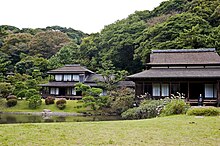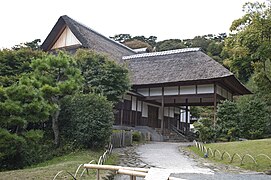Sankei-en
Sankei-en ( Japanese 三 渓 園 ) is a public park in Yokohama . It contains buildings from different centuries and from different parts of Japan.
The founder
The wealthy silk manufacturer and art lover Hara Tomitarō (1868-1939) used the land purchased from his step-grandfather Hara Zenzaburō on the outskirts of Yokohama to rebuild buildings that he had acquired in different parts of Japan. Part of the complex - the Outer Garden - was opened to the general public in 1906. In 1953 the garden was transferred to a foundation, which opened the inner garden to the general public.
The name Sankei , literally Three Gorges , was the stage name ( Gō ) Haras, the appended en means garden.
Hara, like many rich entrepreneurs of his time, dedicated himself to the tea ceremony and not only had old buildings moved, but also new teahouses built. In 1988, a memorial hall ( 三 渓 記念 館 , Sankeien kinenkan ) was completed, in which art objects from Hara's collection and video films are shown.
The layout of the park
The hilly area with an area of 175,000 m² is divided into the inner and outer gardens by the main path. A number of buildings are designated as an Important Cultural Property of Japan and marked with a ◎ . Buildings that are listed as urban cultural assets are marked with a Y. Some buildings can be rented for events.
Inner garden
- Y Gomon , a gate, is said to come from Kyoto and is dated to 1708.
- Y Hakuuntei , a small Sukiya-style building, had Hara built in 1920. It is not open to the public.
-
◎ Rinshunkaku ( 臨 春 閣 ) is a building complex that Tokugawa Yorinobu (1602–1671), the first head of the Kishū branch, had built in 1649. The pictures on the sliding doors ( fusuma ) are by Kanō Tanyū and others. The buildings came into this garden in 1917.
- House 1 consists of four rooms that served as waiting rooms for attending visitors.
- House 2 consists of three rooms. The prince received his visitors in them.
- House 3 consists of five rooms that were used privately.
- Tenzu-ji Jutō Oidō ( 天瑞 寺 寿 塔 覆 堂 ): This house was built by Toyotomi Hideyoshi in 1591 for an object that celebrated the long life of his mother Omandokoro.
- ◎ The Gekkaden ( 月華 殿 ) comes from Fushimi Castle , where it was built by Tokugawa Ieyasu in 1604 .
- Kimmokutsu ( 金毛 窟 ) is a tea ceremony pavilion that Hara had built in 1918.
- ◎ Tenjuin ( 天授 院 ) is a place of prayer for Jizō , the patron saint of children. It was built in 1651 in the zen style in Kamakura.
- ◎ Chōshūkaku ( 聴 秋 閣 ) is a two-story building that Tokugawa Iemitsu had built in 1623 inside Nijō Castle in Kyoto.
- ◎ Shunsōrō ( 春 草廬 ) is a building for the tea ceremony and is said to have been built by Oda Urakusai, the younger brother of Oda Nobunaga . The building is also known as the “nine winds pavilion”.
- Rengein ( 蓮華 院 ) is a tea ceremony house that Hara had built in 1917.
- Y The Rinshōkaku ( 鶴翔 閣 ) is the old residence of the Hara family, built in 1902 as the first large property in the park in the traditional Japanese style. After repairs that stretched over twelve years, it was restored in 2000. In his day, politicians and scholars came and went there.
Outside garden
- Shōfukaku ( 松風 閣 ): This building was erected in 1964, on the hill where the villa of Hara Zenzaburō stood. From the second floor you have a nice view over the park.
- ◎ The three-story pagoda ( 旧 燈 明 寺 三重 塔 ) comes from Tōmyō-ji in Kyoto. It dates from 1457, making it the oldest building in the garden and a symbol of the same.
- Rindōan ( 林 洞 庵 ) is a small building for the tea ceremony that was donated by the Sohen School to the Rindō Tea School Association in 1970.
- Yokobuean ( 横笛 庵 ) is a rural hermitage .
- ◎ The Tōkei-ji Buddha Hall ( 東 慶 寺 仏 殿 ) comes from Kamakura and is dated to the late Muromachi period (1393–1573).
- The Yanohara House ( 旧 矢 箆 原 ) was the house of a village chief in the Shirakawa area of Gifu Prefecture, built around 1750.
- ◎ The main hall of Tōmyō-ji ( 燈 明 寺 本 堂 ), like the pagoda, comes from Kyoto. The free-standing house altar in the Kasuga style ( 春日 厨子 ) inside is the largest in Japan.
Buildings
annotation
- ↑ The Teisha Bridge ( 亭榭 橋 ) with its roof in the Karahafu style is a copy of the Kangetsu-dai in the Kōdai-ji in Kyoto, which Toyotomi Hideyoshi had built for viewing the moon.
literature
- Leaflet of the garden
Web links
Coordinates: 35 ° 25 ′ 1 ″ N , 139 ° 39 ′ 33 ″ E








